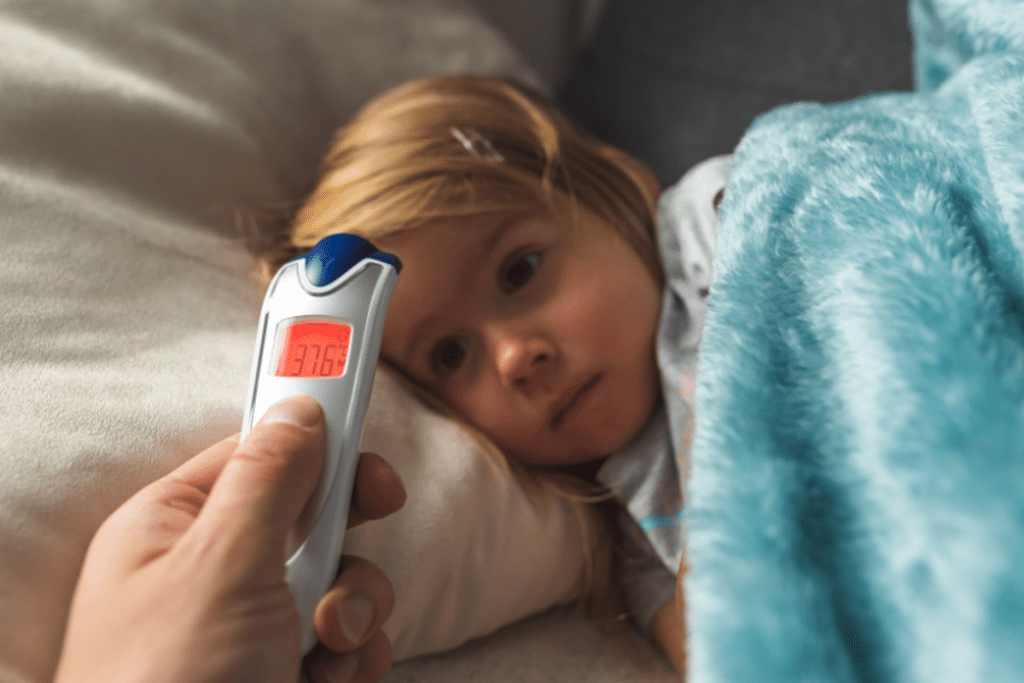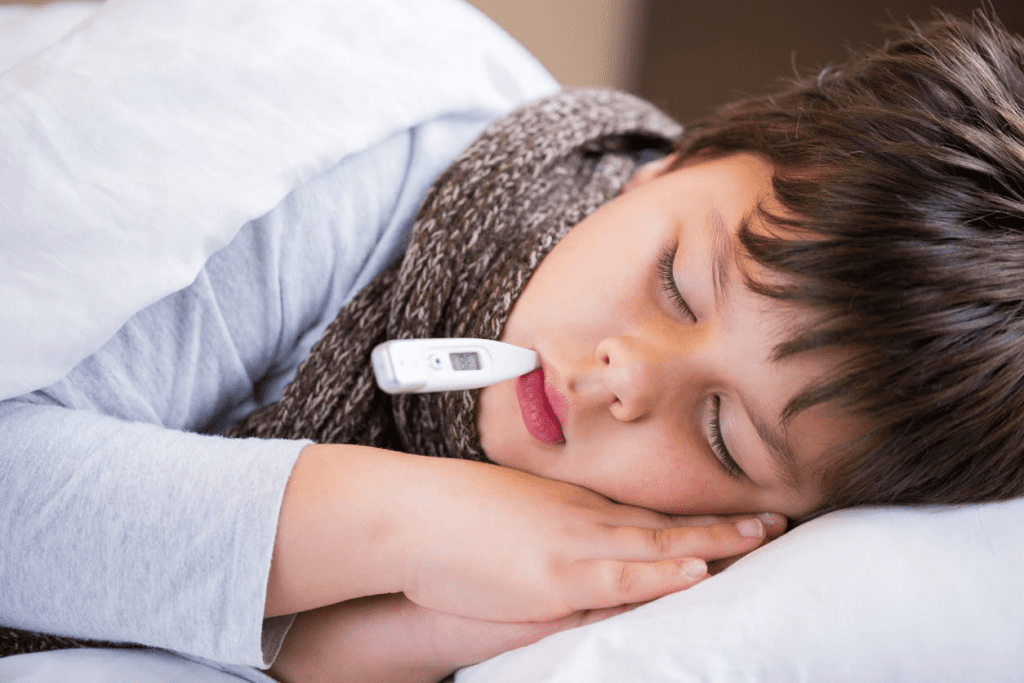Last Updated on November 14, 2025 by
It’s very important to measure a child’s temperature correctly. This helps doctors figure out what’s wrong and how to treat it. Digital thermometers are now the top choice because they are safe and give accurate readings.

Finding the right thermometer can be hard because there are so many options. But digital thermometers are the best because they are precise and easy to use. They come in different types, like oral, rectal, and forehead thermometers, each with its own benefits.
Knowing how to take a child’s temperature accurately is key for parents and caregivers. This article will show you how to use digital thermometers correctly to get reliable results.
Getting the right temperature in children is key in pediatric care. It helps doctors figure out what’s wrong and how to treat it. Fever is a common sign of illness in kids. So, knowing the importance of exact temperature readings is vital for parents and caregivers.

Getting the temperature right is important. It helps doctors find out why a child has a fever. This is because accurate readings help tell apart minor infections from serious ones that need quick medical help.
A study in a medical journal showed how important it is. It said that getting the temperature right is key in diagnosing serious conditions like pneumonia or urinary tract infections in kids.
Key factors influenced by accurate temperature measurement include:
Fever thresholds change with age. What’s normal for an adult might be a fever in an infant. Knowing these age-specific fever thresholds is key to understanding temperature readings.
The American Academy of Pediatrics gives guidelines on fever thresholds for different ages. They stress the importance of considering age when assessing fever.
Wrong temperature readings can lead to wrong diagnoses or delayed treatment. This can harm a child. For example, an overestimated fever might cause unnecessary worry or treatment, while an underestimated fever might delay getting help for a serious infection.
In conclusion, getting the temperature right is essential in pediatric care. It affects diagnosis, treatment, and a child’s health. Both healthcare professionals and caregivers must ensure accurate temperature measurements.
For babies under three months, using a rectal thermometer is the best way. Doctors love it because it’s very accurate and reliable for checking body temperature.

Rectal thermometers are very accurate because they measure the body’s core temperature. Doctors choose this method for babies under three months because it’s so reliable.
The rectal temperature closely matches the body’s core temperature. This makes it a trusted way to check for fever in young babies.
Studies show that rectal thermometers are very accurate and match core body temperature well. They are a key tool in taking care of kids.
They work well because they measure temperature inside the body. This helps avoid the effects of outside factors.
To get accurate and safe readings, it’s important to use the right technique with a rectal thermometer. This means lubricating it, gently putting it in, and holding it until the reading is done.
Parents should be careful and follow the maker’s instructions. This helps avoid any discomfort or harm to the baby.
Rectal temperature checks are best for babies under three months. They are also good for kids who can’t use other ways like oral or axillary measurements.
In cases where getting the exact temperature is key, like when a young baby might have a fever, using a rectal thermometer is the best choice.
Tympanic thermometers are popular for checking body temperature. They measure the ear’s tympanic membrane temperature. This gives a quick and fairly accurate reading.
Ear thermometers detect infrared radiation from the ear’s tympanic membrane. This makes them fast, usually under a second. You insert the thermometer into the ear canal, and it shows the temperature on the screen.
Accuracy is a big plus for these thermometers. They have a mean error of 0.044 °C compared to other methods. This makes them a good choice for temperature checks.
Studies have shown tympanic thermometers are accurate. A mean error of 0.044 °C is seen as acceptable. This means these devices are reliable for medical decisions.
“Tympanic thermometry is a valuable tool in clinical practice, balancing speed and accuracy.”
Medical Research Journal
To get accurate readings, positioning is key. For kids over 1, pull the outer ear back and up. Then, insert the thermometer into the ear canal snugly but gently.
While tympanic thermometers are mostly reliable, there are limits. Issues like ear infections or too much earwax can mess up readings. In these cases, other methods might be needed for accurate temperature checks.
In summary, tympanic thermometers are a handy and fairly accurate way to measure body temperature. Knowing how they work, their benefits, and their limits helps parents and caregivers use them wisely.
Temporal artery thermometers are a quick and fairly accurate way to check body temperature through the forehead. They are popular because they are easy to use and don’t hurt.
These thermometers measure the temperature of the temporal artery, a part of the carotid artery. They detect infrared radiation from the artery as blood moves through it. This is done by scanning the thermometer across the forehead.
The tech behind them is cool. It uses the fact that the temporal artery is near the skin’s surface. This makes it a good spot to measure body temperature without hurting you.
Studies say temporal artery thermometers are pretty good. They’re not as precise as rectal thermometers, but they’re more comfy and simpler to use, which is great for kids.
They’re pretty accurate, with a mean error of about 0.2 °C compared to other methods. This makes them good for both medical and home use.
To get accurate readings, you need to use the right scanning technique. Place the thermometer in the forehead’s center, then slide it towards the hairline while keeping it on the skin.
Key steps include:
Things like extreme temperatures, sunlight, or drafts can mess with the readings. This is because they can change the thermometer’s accuracy.
To get better results, take readings in a room with a stable temperature. Avoid places with direct sunlight or drafts.
Non-contact infrared thermometers are very convenient. But, their reliability is a topic of debate. They measure temperature by detecting infrared radiation from the body. This method is quick and doesn’t require touching.
These thermometers use infrared technology to measure body temperature without touching. They detect radiation from the forehead or other parts of the body. A guide on Best Practice for Forehead Thermometers says it’s important to understand this technology for accurate readings.
Research shows that while these thermometers are convenient, they’re not always accurate. They can struggle to detect low-grade fevers. Various factors, like the environment and how you use them, can affect their accuracy.
Some key findings include:
To get more accurate readings, certain conditions are needed. Use the device in a stable environment, avoid drafts, and keep a consistent distance from the body. Proper technique and calibration are key for reliable readings.
“The accuracy of non-contact thermometers can be significantly affected by environmental factors. Ensuring a stable and controlled environment can improve their reliability.”
Non-contact infrared thermometers are great for quick, non-invasive measurements. They’re useful in mass screenings or with infants. But, for precise clinical assessments, other methods like rectal or tympanic thermometry are better due to their higher accuracy.
In conclusion, while non-contact infrared thermometers are convenient, their reliability depends on several factors. Understanding these factors is essential for accurate readings.
Digital oral thermometers have been used for a long time. They offer a balance between being accurate and easy to use. These devices are common in homes, helping to check body temperature, mainly in kids.
Digital oral thermometers are easy to use, but their accuracy can vary. Studies show they give a good body temperature reading, but not always as precise as other methods. Yet, they are a good choice for many parents because they are non-invasive.
It’s important to think about a child’s age when using these thermometers. They are best for kids aged 4 and up, as younger ones might find it hard to keep the thermometer in place. Also, it’s key to place the thermometer correctly under the tongue, towards the back, for an accurate reading.
There are a few common mistakes that can mess up the readings. These include not waiting long enough for the reading to settle, not placing the thermometer right, and drinking hot or cold drinks before taking the reading. Knowing these mistakes can help get more accurate readings.
Axillary thermometers are a gentle way to check a child’s temperature. They measure the temperature under the arm. This method is great for young kids or babies who might not like other ways of taking their temperature.
To get accurate readings with an auxiliary thermometer, follow these steps. Place the thermometer in the armpit, making sure it touches the skin, not clothes. Hold the arm close to the body until it beeps, showing the reading is done.
Key steps for accurate axillary temperature measurement:
Axillary temperature readings are often lower than the body’s core temperature. The difference can be from 0.5 °C to 1 °C. This difference is important when checking for fever, as it can make the temperature seem higher or lower.
For example, a child with a core body temperature of 38 °C might show an axillary reading of around 37 °C or lower. So, when using auxiliary thermometers, it’s important to remember this difference to make the right decisions.
The accuracy of axillary thermometers can change with age. For babies and young kids, they are a good choice because they are easy to use. But for older kids, other methods like tympanic or oral thermometers might be more accurate.
Reliability by age:
In summary, axillary thermometers are a good option for checking temperature, but their accuracy depends on the child’s age and the situation.
Choosing the right thermometer is important. It depends on your child’s age and needs. There are many types of thermometers, each with its own benefits and drawbacks.
Knowing the strengths and weaknesses of each thermometer helps caregivers make better choices. Rectal thermometers are often seen as the most accurate. But tympanic and temporal artery thermometers are easier to use and also accurate.
Think about your child’s age and what you need when picking a thermometer. For example, non-contact infrared thermometers are easy to use. But, they might not catch low-grade fevers well.
Choosing the right thermometer means you get accurate readings. This helps you take good care of your child. By picking the best thermometer, you can keep an eye on your child’s temperature and make smart health choices.
Rectal thermometers are the most accurate for babies under 3 months. They give the best readings.
To use a rectal thermometer right, follow these steps. Make sure it’s lubricated and gently insert it into the rectum.
Tympanic thermometers, or ear thermometers, are pretty accurate. They have a small error compared to other methods. But, it’s important to position them correctly.
Tympanic thermometers might not work well with ear infections or too much earwax. This can affect the readings.
Temporal artery thermometers scan the forehead to measure temperature. They are accurate and easy to use.
Non-contact infrared thermometers are handy. But, their accuracy is a worry, mainly for low fevers. They need the right conditions for better readings.
Yes, you can use digital oral thermometers. But they have age limits. Make sure to place them correctly for accurate results.
Axillary thermometers are less invasive. But, they’re not as accurate. It’s important to know the difference in temperature readings.
The best thermometer depends on your child’s age and needs. Choose the one that fits their specific requirements.
Knowing the pros and cons of each thermometer type helps. This way, you can pick the best one for your child.
Subscribe to our e-newsletter to stay informed about the latest innovations in the world of health and exclusive offers!